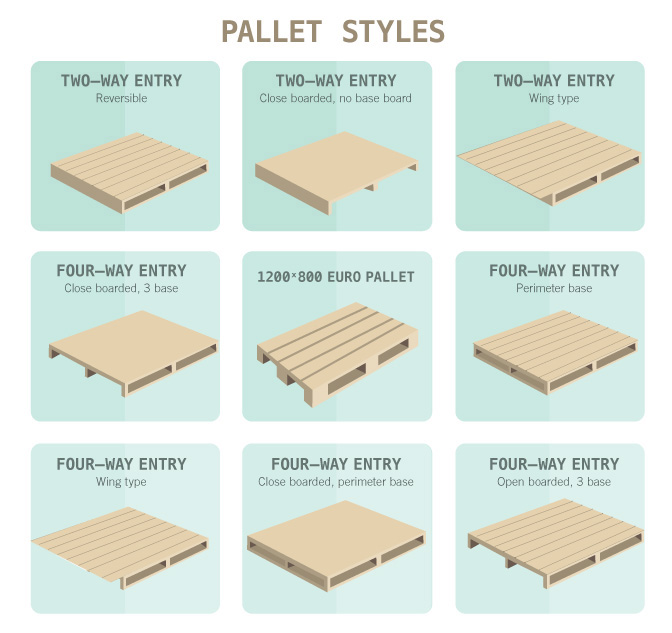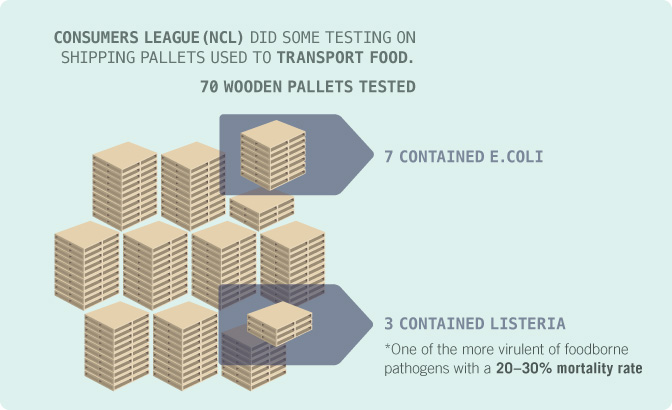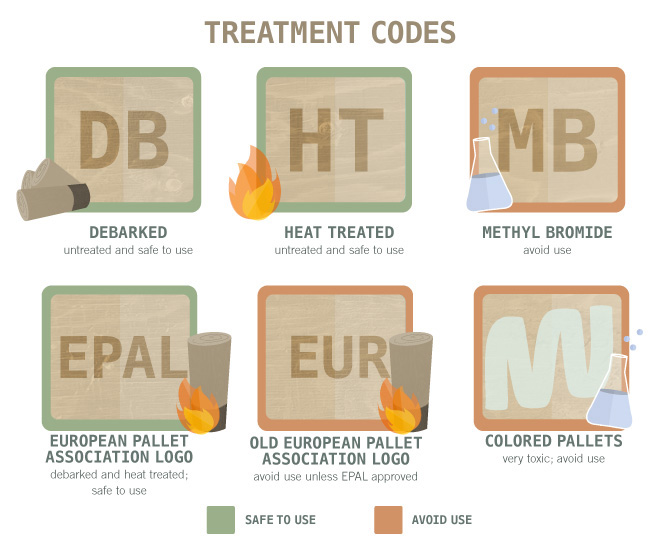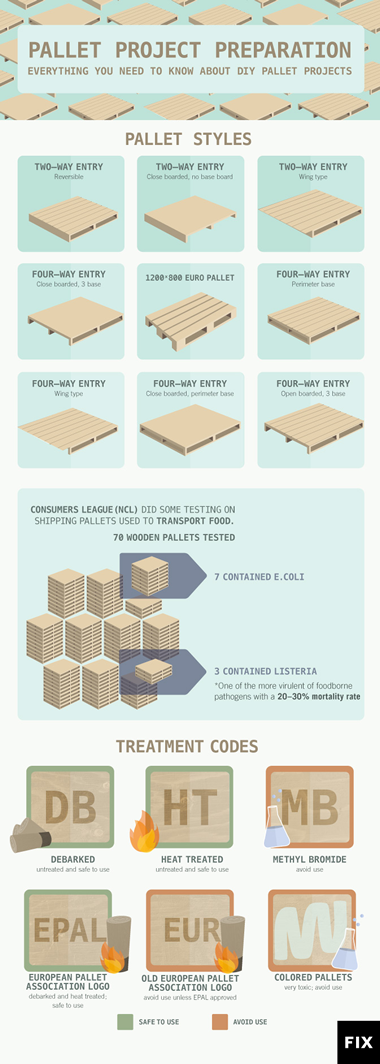Preparing Wooden Pallets for Upcycling Projects
After being used as a basic wooden frame to load and transport goods via forklift, truck, and ship, the simple pallet can be transformed into numerous works of furniture art ranging from coffee tables, shelving, and picture frames to armoires, night stands, and bunk beds.
Best of all, pallets are free. Since they “grow” just about everywhere, getting a few to throw in the back of the car is a simple job – right? But before you start collecting pallets, you may want to consider that some pallets can be dangerous: Chemical spills and treatments can make some pallets hazardous to cut, burn, or even touch.
The following guide will help you get on the right track when it comes to finding the best pallets, breaking them down, and using them for your next DIY home improvement or woodworking project. Be safe and enjoy your next pallet project!
Styles of Pallets
Most people think that all pallets are the same, but there are a variety of styles. Choosing the right pallet can mean the difference between finding the safest and best materials versus using damaged wood that may contain toxic chemicals.

Choosing a Safe Pallet
Because pallets are used multiple times for transporting a wide variety of materials, they can be susceptible to spills from all sorts of nasty liquids and products. The first rule when selecting any pallet is to check if it has anything visible spilled on it. It’s best to discard anything with any spills, stains, or strange discolorations. Stick with a clean, stain-free pallet.

Once you’ve found a spotless pallet, the next step is to check for a stamp or marking on the sides or stringers of the pallet. If you see no numbers, words, or symbols stamped, branded, etched, or painted on the sides of the pallet, then you’ve likely found a safe and clean pallet. For most domestic transportation purposes, a non-treated wood pallet requires no markings.
Aside from a company’s logo, other official-looking markings on the sides of the pallet often mean your pallet has been shipped internationally. Along with a few symbols, a country-of-origin abbreviation, and a registration number, there are two things you should be on the lookout for when you find markings on the side of a wooden pallet:
1) IPPC Logo: If your pallet comes from abroad and does not have this seal of approval, you don’t know what it’s been used for or treated with.
2) Treatment Code: Typically found in the lower center of the mark, this two-to-four-letter code tells the tale of what was used to treat the pallet materials. The treatment coding is as follows:
- DB: Debarked. This procedure removes the bark using a cutting tool and the pallet wood remains untreated. Pallets marked with the letters DB are chemical-free and safe to use.
- HT: Heat-treated. The process of heat treating begins by plunging a freshly made pallet into the heart of a raging kiln for 30 minutes to ensure bugs stay away without the need for chemical treatment. Pallets marked with HT are untreated and safe to use.
- MB: Methyl Bromide. This poisonous fungicide not only kills fungus, but it can make you sick as well. Banned in Canada, pallets marked with an MB stamp should be avoided; if you see one of these pallets, dispose of it in the proper place.
- EPAL: A European Pallet Association Logo. It simply means the pallet has been debarked and heat-treated.
- EUR: The old version of EPAL. Pallets of this type are rare, but should be avoided in general unless also EPAL-approved.
- Colored Pallets: More often than not, a colored pallet once shipped a pool chemical and can be very toxic. Even though they might look cool, avoid colored pallets for woodworking projects.

Locating the Perfect Pallet
Where do you find the best free wooden pallets that are safe from pesticides, chemicals, and other toxic ingredients? The following list of safe locations can help you get a quality supply of free wooden pallets for your next woodworking pallet project.
Feed and Tack Supply: One of the best places to get used pallets is from a feed, tack, or pet supply store. Their pallets are typically made from soft woods and carry nontoxic animal food supplies.
Residential Construction Site: Pallets from construction sites typically carry cement, felt paper, and joint compound – all nontoxic materials. Always be sure to ask the builder before you take from a residential construction site and avoid commercial construction sites as they may have toxic pallets in their possession.
Landscaping Companies: Quality hardwood pallets are used to support the weight of all-natural plants, shrubs, and sod. Avoid colored pallets that have been used to carry fertilizers.
Newspaper Delivery and Distribution Centers: More often than not, a quick chat with one of the drivers, loaders, or office managers will be enough to allow you take away these heavy-duty, four-way, hardwood pallets. Just don’t forget to get permission, or you could end up in hot water.
Hardware and Lumber Store: You can always find a pallet or two lying around a lumberyard. Just be wary of which ones you take. Some lumberyards and hardware stores carry toxic pallets that may have been chemically treated to prevent corrosion, or accidently sprayed with spilling chemicals when loading or transporting.
Prepping a Pallet
Great care should be taken when disassembling your pallets; after all, you don’t want to bust up your hard-earned discount wood! A few methods are less desirable than others to break down a pallet into its usable components so it’s a good idea to go over the basics.
• Hammer, Pry Bar, and Cat’s Paw: A small cat’s paw or pry bar, a flat clawed hammer, and a block of wood are all you really need to break apart a pallet without damaging the surface of the wood.
• Nail Punch: Using a nail punch to drive rather than pull the nails free can be the preferred method on stubborn ring, screw, or spiral-shanked nails. Pneumatic nail punches work even better, but can cost a pretty penny.
• Oscillating Tool: By loosening up tight planks with a pry bar first, you can expose the nail shank to the cutting blade of an oscillating tool and make quick work of rusty nails.
• Drill: When the above methods won’t work and you’re stuck with a nail that won’t budge, you can always use a metal drill bit and drill to remove ancient pallet nails.
• Clean Cut: Last but not least (and if all else fails) you can quickly cut the pallet planks and leave the pallet ends and nails still attached to the stringer.
Cutting, Shaping, Sanding, and Finishing Tips
After all of the hard work of finding and breaking down your pallet pieces, you’ve still got to cut, shape, sand, and finish your materials before they are ready to be assembled into something new and fantastic. The easiest way to get your pallet projects started off on the right foot is by shaping, sanding, finishing, and cutting your materials prior to assembly.
Because pallet materials are unfinished, they can be pretty rough – rough enough to cause a few painful splinters. But it’s also their rough nature that makes them so appealing, and sanding down to a smooth surface often takes away the aesthetic patina of a pallet’s natural state. If you’re going for the clean look of new wood, avoid lengthy sanding and go for a quick pass through a wood planer for clean, crisp, wood. However, if you like the tarnished veneer of your ancient pallet but want to make it smooth to the touch, use natural beeswax finishing products to highlight your pallet’s well-worn finish without keeping the sharp and dangerous splinters hanging around.
When cutting and shaping pallet materials, it’s often wise to avoid making cuts near nail holes, splits, or cracks in the wood. As wood ages on pallets, it shrinks. This makes the wood more susceptible to splitting and breaking during a cut.
Always be sure to sand your pallet materials in an outdoor setting and avoid breathing any dust by using a respirator. Dust and debris from sanding a pallet may contain traces of toxic materials from shipping spills, even if the pallet was never used to ship poisonous products. In lieu of sanding rough edges, a hand planer may be the best tool for the job to avoid creating potentially toxic dust.
Pallet projects can range from creating an Adirondack chair to an outdoor garden bed. There are thousands of ways to upcycle a pallet into a piece of furniture or work of art. Creating an upcycled piece of art or furniture from a pallet is the perfect way to reuse wood that would otherwise be thrown away. Now that you have all the information about choosing the right pallet and preparing it for use, it is time to start your project.
Embed the article on your site

